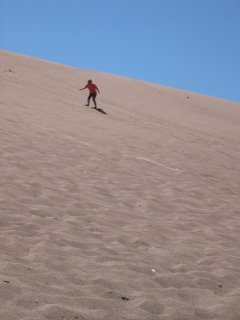Hamish and I woke early and had breakfast at the designated meeting place. We were setting off to mountain bike down the "World's most dangerous road". Now, I thought that this designation was dreamt up by the marketing department of Gravity Assisted Mountain Biking- the first company to organise the descent on mountain bike, but I was wrong. The road was in fact named as the world's most dangerous road by the Inter American Development Bank in 1995. It was so named because in 1994 no fewer than 26 vehicles had fallen over the side, accidents which invariably resulted in the death of all occupants. The death toll in the last ten years has not abated with a fatal accident occurring on average every two weeks amounting to two hundred deaths per year.
The road was built by prisoners in 1932 and connects La Paz to Coroico, the Yungas and low lands beyond. It is the main thoroughfare for those traveling from La Paz to Brazil- a journey which takes around a week. The fact that the drivers have driven for so long without a break and with only extract of the coca plant to keep them awake may account for some of the danger of the road. The rest of the danger comes from the road itself. It is a dirt track, barely passable in the wet season, at some points the road is only three meters wide and beyond that is at least a 500 meter drop- and never less than the distance required for a falling object to reach terminal velocity. There are of course no barriers to protect the users from the abyss. Some years ago, the Bolivian government decided that the road would be open to traffic in only one direction, on alternate days. It was acknowledge, however, that this system would not work when it transpired that a small bribe at the police check point circumvented the system - allowing cars to pass on the wrong day- making the road twice as dangerous as before. Instead, a new system was adopted whereby uphill traffic has the inside track on the left and the downhill traffic is on the outside. We were told that this is because the uphill, often heavily laden traffic, always has priority and does not stop but it is also so that the drivers of the downhill traffic- with the drivers seat on the right- can see just how close to the afterlife they are.

We set off in the bus, bikes mounted on top, for La Cumbre 4, 700 meters above sea level and at the foot of the Huayna Potosi mountain (6,088). There we were given our bikes and we adjusted them and circled around to get used to them. This was my first real mountain biking expereience, but not even rudimentary instructions were given to me on how to approach this!
The first 20 km was on paved road. This gave us time to adjust to riding the bikes and was thoroughly enjoyable- the bikes reach up to 80 km/hr. The temperature at the top of the mountain was very cold and it was a real struggle to be able to get our hands to function the brakes, but I guess our survival instinct kicked in.
1600 km down we reached the Unduavi drug paraphenalia checkpoint where we had to dismount and walk through. On the other side were several food stalls and many stray dogs. The Bolivians believe that the stray dogs are the returned souls of those who have died on the road and so are treated well. On the other side of the check point we had to commence a 5 km up hill. It was not very steep but at over 3000 m above sea level it was very hard work.
After the uphill we were given instructions on the off-road down hill and we set off. The first few hundred meters were very rough and I had serious doubts as to whether or not I was up to the task. The instructor told us that no one had died with their company- this was supposed to increase our confidence although the qualifier led us to deduce the obvious- that people had died with other companies. In fact, I later learnt that this was the case- several mountain bikers have died, many more injured and some saved only by hurling themselves off the bike before it went over the edge.
Little by little, however, my confidence increased and I let go of the breaks for longer periods of time. Hamish and the other guy in our group were fast. I, meanwhile, was comfortable bringing up the rear!


The path down is littered with reminders of the death toll- crosses, shrines and memorials decorate the edge of the road. On some of the most dangerous bends men and women stand in all conditions and signal to the oncoming traffic if it is safe to pass. We were told that the people all come from the same family- that of a man who lost his wife and children to the cliff and was determined to do something about it. They are paid only by the donations of passers by. Not all deaths on the road are, however, accidental. We were told the story of a Bolivian election where the opposition party became aware that they were not going to win the election. They took five of the most senior members of the government party and drove them to the La Paz- Coroico road and pushed them over the side.
Further down the road widens and improves. By this time I was getting the hang of the bike and was able to let myself go to a far greater extent. It was amazing to feel the wind in my hair, the mud flying up to obscure my vision and all the while surrounded by the most incredibly beautiful countryside. It was brilliant to be able to ride under waterfalls goings over the road, and we managed to get a tad wet going through a few rivers the cross the road as well. The weather at La Cumbre had been perfect but most of the descent had been in the mist. I was not too unhappy not to be able to see the drop when we were high up but as we came closer to Coroico we were below the mist and could see all the way down the splendid valley.

We arrived at the small village at the bottom where we had a well deserved cold shower. It felt really great to be at the bottom- it was an incredible experience and the adrenalin was pumping so hard once we got down that we would happily have driven back up and done it all over again.
With a little more distance I am in two minds about the excursion. I read a few articles to get some facts to write this diary and read one article in particular written by a British guy who did the same trip but came across the cyclist who had fallen over the edge. He was with a friend who had trained in emergency medicine and another who had training in mountain rescue. They did their best to reach the woman and get her help- although the nearest hospital was well over two hours away. By the time they had managed to get her back up to the road she was already dead. He concluded that the road was too dangerous to be a tourist activity. He also thought that the trip was disrespectful to the locals who have no choice but to use this road and the tourists only make it more dangerous. It is hard to balance the truth of that argument against the income for the Bolivian economy that comes from this hugely popular (and quite pricey) tourist attraction. Still, it is a valid point and one that I had not considered before setting off on the trip.
Serious issues and dangers aside, having made it down the 72kms and 3600 metres in altitude in one piece I have to say that it was one of the most thrilling experiences of my life and I would still, despite everything, recommend the trip to others.





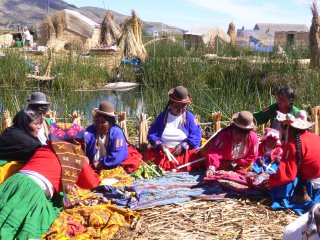













 We bought dynamite (even kids can buy it in Potosi) a bottle of 96% alcohol (we all had to drink a mouthful before entering the mine) and bags of coca leaves (the miners´s staple diet). And yes, that is a stick of dynamite in my mouth!
We bought dynamite (even kids can buy it in Potosi) a bottle of 96% alcohol (we all had to drink a mouthful before entering the mine) and bags of coca leaves (the miners´s staple diet). And yes, that is a stick of dynamite in my mouth!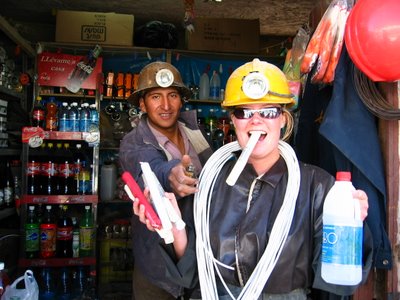
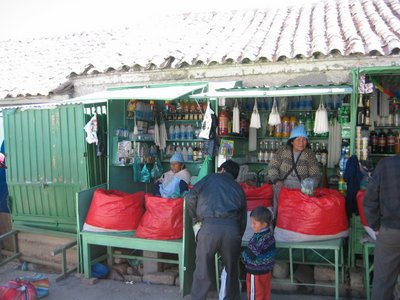
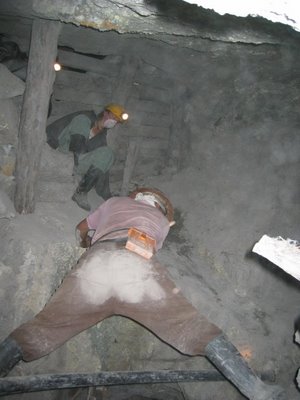







 The next stop was the Largo Colorada- a red lake inhabited by thousands of Flamingos. It was very beautiful and we were told that we could walk around the lake and join the jeep at the other side. This gentle stroll around the lake was the last straw for our fragile bodies. I got back in the jeep and felt unwell, and Hamish froze the entire way around the lake. Fortunately, it was not far to the basic hostel which would be home for the night. It was only 4.00 pm or so but all of us in the jeep went straight to bed.
The next stop was the Largo Colorada- a red lake inhabited by thousands of Flamingos. It was very beautiful and we were told that we could walk around the lake and join the jeep at the other side. This gentle stroll around the lake was the last straw for our fragile bodies. I got back in the jeep and felt unwell, and Hamish froze the entire way around the lake. Fortunately, it was not far to the basic hostel which would be home for the night. It was only 4.00 pm or so but all of us in the jeep went straight to bed.
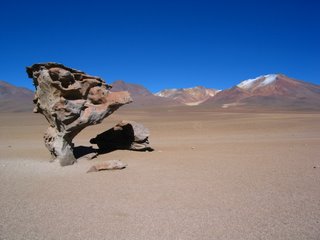

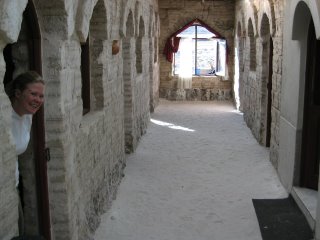

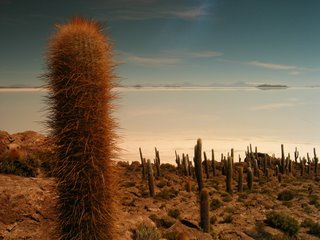



 Bahia Inglesia - a great place to relax, have a game of international soccer, a bbq cooked by our guides and a couple of local vinos:
Bahia Inglesia - a great place to relax, have a game of international soccer, a bbq cooked by our guides and a couple of local vinos:







